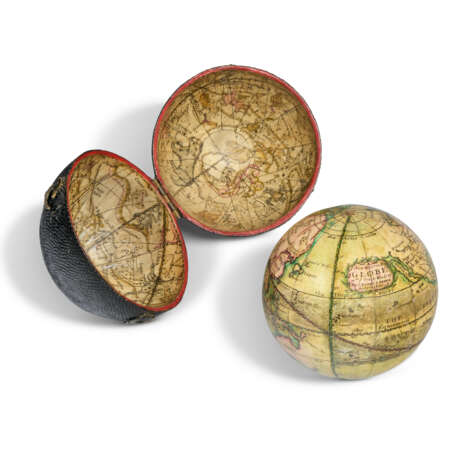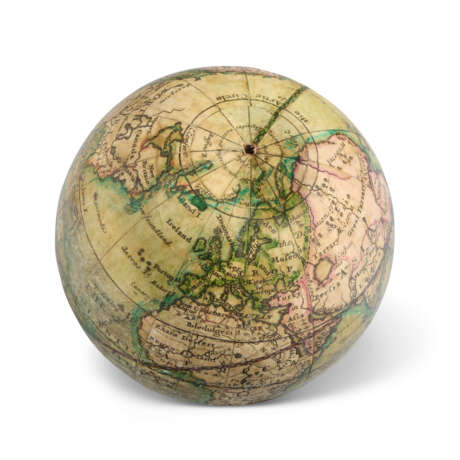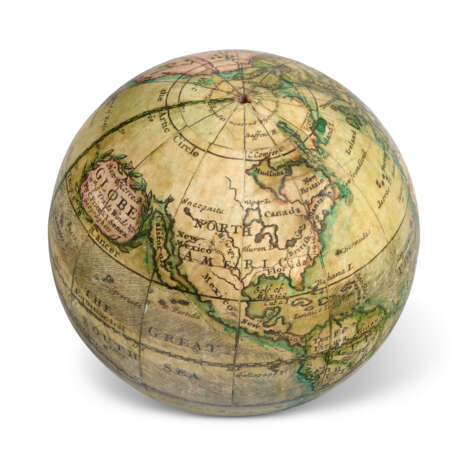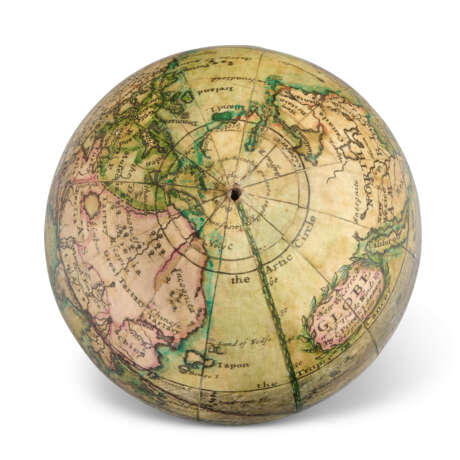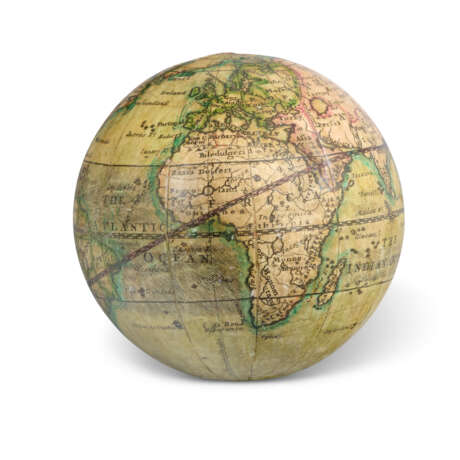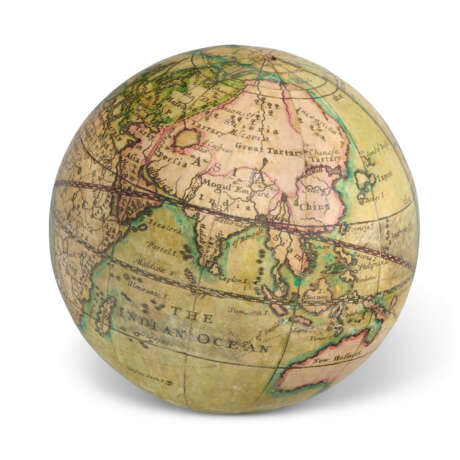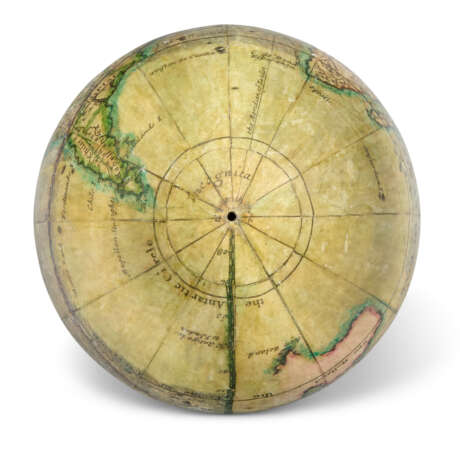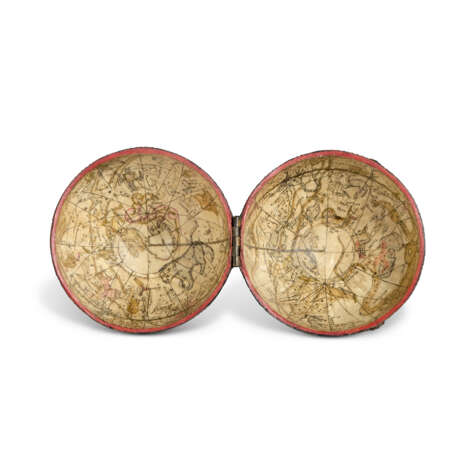ID 1249803
Лот 113 | PRICE, Charles (fl.1697-1733) and John SENEX (1678-1740)
Оценочная стоимость
£ 20 000 – 30 000
AN EARLY ENGLISH 2¾-INCH POCKET GLOBE, CIRCA 1710
The second earliest English pocket globe.
This finely engraved pocket globe was a joint venture between London globe makers Charles Price and John Senex. The pair first advertised in the London Gazette of 6 May 1706 a 'New pair of Globes, Twelve Inches Diameter'; they then shared a shop from 1707-1710: 'at their house in Whites Alley in Coleman St.' Price left the partnership in 1710 to begin a collaboration with George Willdey and then partnered with Benjamin Scott in 1714. The Price & Senex pocket globe was produced in the final year of their partnership, around 1710.
The detail on the engraving is impressively meticulous. The place names are rendered in minuscule precision, allowing for a high degree of cartographic detail and finish. Around the north pole, there is a quotation in Latin from Virgil's Aeneid (III, 56): 'Quo non Mortalia pectora cogit Auri sacra fames' - 'To what extremes will you not drive the hearts of men, accurst hunger for gold!' (trans. Robert Fitzgerald, 1986). There is something resolutely English here in the selected quotation and its placement in the Arctic circle. Of course a reference to the still-elusive Northeast and Northwest Passage to Asia, the accursed 'Auri' also recalls the English sailor and privateer Martin Frobisher's three voyages to the New World (1576-1578) to find the promised Northwest passage. Frobisher found deposits in Canada of what he thought was gold ore; but after extensive mining and years of smelting, the ore turned out to be worthless iron pyrite. Frobisher's gold from the Arctic was nicknamed Fool's Gold.
Another reference to English, maritime history is the reproduction of the tracks of Francis Drake's voyage around the world (1577-1580). A nice detail from the cartographers is the labelling of 'Drake returns' around the Cape of Good Hope. The minuscule text is actually engraved upside down around the Southern tip of Africa, so that in order to read it, the globe must show South-pole up. This is the only text on the pocket globe with this reverse orientation, and there is something delightfully playful in the quick rotation of the globe south-side up. All possible in the palm of the hand, of course, thanks to the globe's miniature size. There is also perhaps something of the daunting exceptionality of Drake's voyage, more than a century before the pocket globe was produced. The famed English explorer beheld the world upside down, just as his admirers reading his name on the pocket globe must do.
The quickly-succeeding collaborations and partnerships of Charles Price in the 1710s and 1720s heralded an unstable and ultimately ruinous career; Price spent one of his final Christmases in Fleet prison in 1731, and died in 1733. John Senex, on the other hand, went on to enjoy an illustrious and successful career until his death in 1740. He continued developing his cartographical practice, first in partnership with John Maxwell until 1721, and then independently when he was elected Fellow of the Royal Society in 1728, a title he proudly displayed in subsequent signatures. He issued a new, 2¾-inch pocket globe in 1731, dispensing with the old Price & Senex plates; the cartouche on this later edition also does away with Price's laurel-leaf border for a rectangular frame: A New & Correct GLOBE of the Earth By I. Senex F.R.S.
John Senex's legacy on eighteenth-century English globe making was long-lasting. Globe makers were still issuing new editions of his globes with Senex's name still on the cartouche until 1793. The pocket globe here is a rare survival from early in John Senex's and Charles Price's careers, and is a testament to the burgeoning pocket globe industry in London at the turn of the eighteenth century. Comparatives are few and far between: the Royal Museums Greenwich have a Price & Senex pocket globe in their collection (GLB0013).
The globe comprised of twelve hand-coloured engraved gores and two polar calottes, the cartouche signed New & Correct GLOBE w.th Trade Winds &c By C. Price & I. Senex Geographers, the terrestrial globe with graduated equator, the Meridian of London labelled, the location of the Antipodes to London marked, the ecliptic graduated on one side between the poles, finely hatched lines indicating trade winds between the tropics, the map showing New Holland and New Zealand part delineated, although New Zealand assigned to Tasmania and New Zealand itself not drawn, Dampier Strait labelled Dampiers Str, North-West America as Incognita, California as an island, no hypothetical southern continent but inside of antarctic circle labeled Incognita, around the north pole a quotation in Latin; contained in a spherical fishskin-covered case, each interior hemisphere lined with two sets of twelve hand-coloured engraved celestial gores and two polar calottes, the equatorial graduated in degrees, the ecliptic graduated in days of the houses of the Zodiac, labelled magnitude table in front of Ursa Major, Cor Caroli depicted, a total of 22 stars and three star groups named, the 48 Ptolemaic constellations and two of the non-Ptolemaic constellations, as well as two of the southern constellations and those of Plancius and one of Hevelius (RMG count), depicted by mythical beasts and figures and some objects, the edge painted red and with two brass hooks and eye clasps.
3 in. (7.5 cm.) diameter in case
| Автор: | Чарльз Прайс (1697 - 1733) Джон Сенекс (1678 - 1740) |
|---|---|
| Категория аукционного дома: | Все остальные типы объектов, Карманные часы |
| Автор: | Чарльз Прайс (1697 - 1733) Джон Сенекс (1678 - 1740) |
|---|---|
| Категория аукционного дома: | Все остальные типы объектов, Карманные часы |
| Адрес торгов |
CHRISTIE'S 8 King Street, St. James's SW1Y 6QT London Великобритания | |
|---|---|---|
| Предосмотр |
| |
| Телефон | +44 (0)20 7839 9060 | |
| Комиссия | see on Website | |
| Условия использования | Условия использования |
